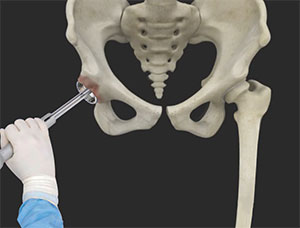Robotic Total Hip Replacement

What is Total Hip Replacement?
Total hip replacement is a surgical technique where the severely damaged cartilage and bone of the hip joint are removed and substituted with an artificial prosthesis which is bio-compatible and functions like a normal hip. It is one of the most common joint replacement procedures, subsequent to knee replacements. The main aim of this surgery is to restore function to the joint and relieve pain.
What is Robotic Total Hip Replacement?
Robotic total hip replacement is a minimally invasive procedure where your surgeon is assisted by a robotic system to perform a total hip replacement surgery.
Indications for Robotic Total Hip Replacement
Patients qualified for robotic total hip replacement experience moderate to severe hip arthritis, such as rheumatoid arthritis, osteoarthritis, post-traumatic arthritis, causing pain and interference with activities of daily living. This includes:
- Moderate to severe pain even while resting that affects sleep
- Difficulty in walking, bending, or climbing stairs
- Stiffness in the hip due to joint degeneration that limits movement
- Failure of conservative treatments to alleviate hip symptoms
Contraindications for Robotic Total Hip Replacement
Robotic hip replacement surgery is contraindicated in patients who:
- Are obese or overweight
- Have undergone other hip surgeries
- Have significant hip joint deformity
- Are very muscular
- Have health issues that may slow wound healing
What Happens During Robotic Total Hip Replacement?
The robotic system consists of a surgeon's console, robotic arms, a high-performance vision system, and special surgical instruments. A computed tomography (CT) scan is taken before the surgery to create a 3D model of the affected hip joint. During surgery, the information provided by the CT scan is interpreted by the robotic system and guides your surgeon with the procedure. The 3D camera provides your surgeon with a magnified view of the operating area. Your surgeon sits at a console and controls the movement of the robotic arms holding the special surgical instruments. The movements of your surgeon’s hands are translated by the robotic system into precise movements of the miniaturized instruments that are held by the robotic arms. The enhanced vision and superior control of the micro-instruments improve the precision of the surgery. This accuracy helps repair the damaged joint and optimally position the prosthetic implant while ensuring minimal injury to neighboring tissues.
Postoperative Care Instructions
Postoperative instructions to aid in the healing and recovery process usually include:
- Use of assistive devices such as a splint or crutches for walking
- Keeping your leg elevated
- Medications to control pain and swelling
- Limited weight-bearing activities
- Following a balanced, varied diet
- Physical therapy to improve flexibility, range of motion, and strengthen muscles
- Adhering to follow-up appointments
What are the Advantages of Robotic Total Hip Replacement?
Robotic total hip replacement surgery offers the following benefits:
- Smaller incisions leading to reduced scarring
- Minimal blood loss
- Less postoperative pain
- Shorter hospital stay and recovery period
- Quicker return to daily normal activities
- Precise placement of the hip implant with a reduced risk of hip dislocation
- Improved safety and reduced risk of injury to adjacent tissues
- Increased longevity of the implant
What are the Risks and Complications Associated with Robotic Total Hip Replacement?
Robotic hip replacement is generally a safe procedure. However, as with any surgery or procedure, possible complications may include:
- Damage to nerves and blood vessels
- Leg-length discrepancy
- Fracture
- Infection
- Dislocation
- Bleeding
- Deep vein thrombosis
- Implant wear and loosening
Related Topics:
- Minimally Invasive Direct Anterior Approach
- Total Hip Replacement
- Mini-Posterior Hip Replacement
- Robotic Total Hip Replacement
- Posterior Hip Replacement
- Outpatient Anterior Approach Hip Replacement
- Correction of a Failed Hip Replacement
- Outpatient Hip Replacement
- Hip Resurfacing
- Physical Therapy for Hip
- Minimally Invasive Total Hip Replacement
- Revision Hip Replacement
- Computer-assisted Hip Replacement
- Robotic Assisted Hip Surgery
- Robotic Assisted Hip Replacement






